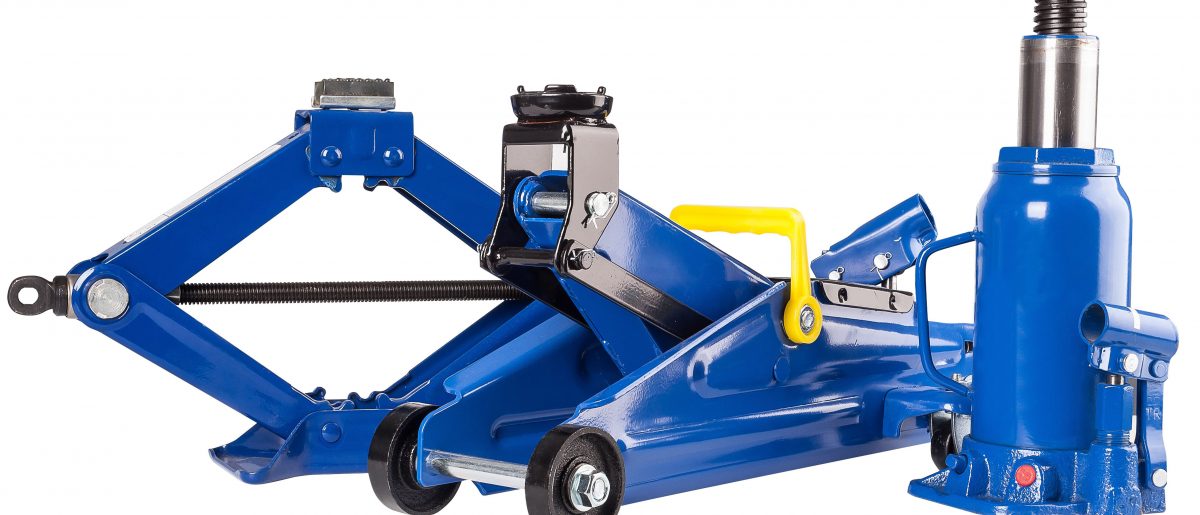A jack is a basic tool that should be found in any DIYer’s garage. It’s also a crucial piece of safety equipment, a must-have in your trunk or cargo area should you ever find yourself stuck dealing with a flat tire and no cell phone service.
That being said, there are several different types of jacks on the market, and while each have their strong points, not all of them are appropriate for every vehicle type or repair job.
Which jack is the best fit for your needs? Let’s take a quick look at the basic information you need to keep in mind when purchasing a jack for use with your vehicle.

Three of a kind
There are four basic jack configurations you are likely to encounter in your shopping process.
The first is a scissor jack, which center around a mechanical screw that activates hinged steel limbs on either side of the jacking point to lift or raise the load. These jacks offer a solid, wide base that is useful on a wide variety of surfaces, while also delivering a small form factor that is easy to stash behind a seat or in the trunk.
Next up you’ll find hydraulic jacks, of which there are generally two designs. A bottle jack is so named because its hydraulic cylinder represents a small bottle standing on its end. This jack provides a taller-than-average lift height yet is still small enough to be easily portable. The other one is the floor jack, that provides a much lower profile jacking point and spreads the load out across a longer and wider axis, typically on wheels, making it a favourite for garage use.
Finally, there is the Hi-Lift jack or bumper jack. “Hi-Lift” might be a brand name, but it’s one that’s been around for more than 100 years and as such has fallen into common usage among the off-roaders that have been loyal customers. As the name might suggest, it’s intended to offer an extended range of lift, and resembles a single-legged iron trestle with a mechanical lever attached to it.

Which one for what job?
One might expect that a jack’s size has to do with its lifting ability – and in some senses, this is correct. It’s important to match the form factor of the jack with the job that needs to be done. For example, if you have a truck or an SUV that features tall ride height, a bottle jack or a Hi-Lift will most likely be best able to provide the range you need to get a wheel off of the ground. By the same token, a scissor jack or a floor jack may be needed to slide under a lower vehicle.

It’s equally important, however, to consider the weight rating attached to the jack you are using. Even though a bottle jack might look physically smaller than a floor jack, it might be rated to carry a heavier load. Jack capacities are listed in tons, with a 2-ton jack capable of handling most cars and small SUVs and a 3-ton jack being a match for the majority of trucks and full-size SUVs. It’s never safe to rely on a jack to hold up the entire weight of your vehicle, and never under any circumstances place yourself underneath a car or truck unless it’s being supported by jack stands.
Putting it all together
Taking into account all of the above, there are three important considerations to make when choosing a jack:
- The environment it will be used/stored in (trunk of a car versus pickup truck bed versus garage).
- The weight it needs to lift (measured in tons).
- The height of the vehicle it’s going to be used with.
Match each of these criteria to your needs, and you’ll be sure not to be frustrated the next time you need to swap a tire, bleed your brakes, or work on your vehicle’s chassis.
Check out all the service jacks available on napacanada.com or trust one of our 600 NAPA AUTOPRO locations for routine maintenance and repairs. For more information, chat with a knowledgeable expert at your local NAPA Auto Parts store.
By Benjamin Hunting








Great tips for everyday drivers to follow, thanks NAPA!